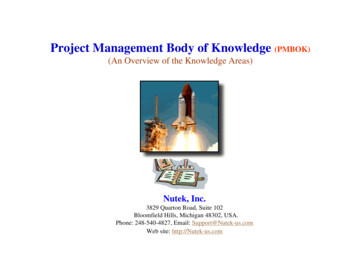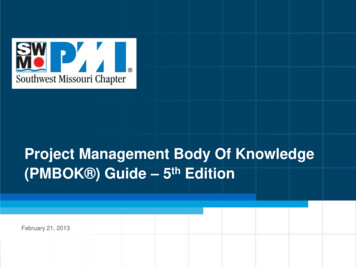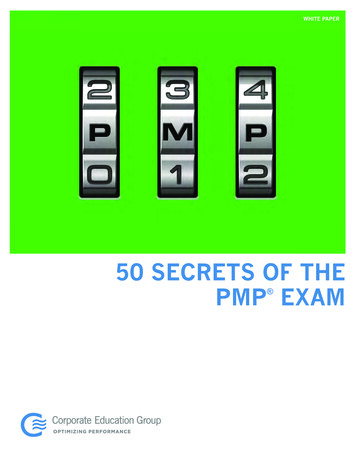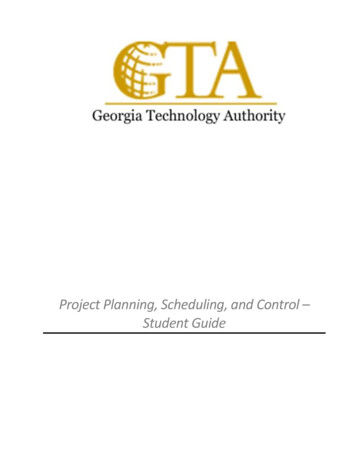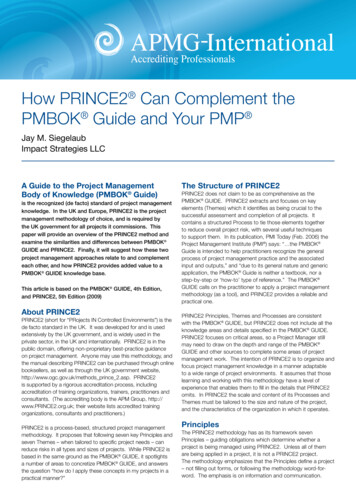
Transcription
InternationalHow PRINCE2 Can Complement thePMBOK Guide and Your PMP Jay M. SiegelaubImpact Strategies LLCA Guide to the Project ManagementBody of Knowledge (PMBOK Guide)is the recognized (de facto) standard of project managementknowledge. In the UK and Europe, PRINCE2 is the projectmanagement methodology of choice, and is required bythe UK government for all projects it commissions. Thispaper will provide an overview of the PRINCE2 method andexamine the similarities and differences between PMBOK GUIDE and PRINCE2. Finally, it will suggest how these twoproject management approaches relate to and complementeach other, and how PRINCE2 provides added value to aPMBOK GUIDE knowledge base.This article is based on the PMBOK GUIDE, 4th Edition,and PRINCE2, 5th Edition (2009)About PRINCE2PRINCE2 (short for “PRojects IN Controlled Environments”) is thede facto standard in the UK. It was developed for and is usedextensively by the UK government, and is widely used in theprivate sector, in the UK and internationally. PRINCE2 is in thepublic domain, offering non-proprietary best-practice guidanceon project management. Anyone may use this methodology, andthe manual describing PRINCE2 can be purchased through onlinebooksellers, as well as through the UK government website,http://www.ogc.gov.uk/methods prince 2.asp. PRINCE2is supported by a rigorous accreditation process, includingaccreditation of training organizations, trainers, practitioners andconsultants. (The accrediting body is the APM Group, http://www.PRINCE2.org.uk; their website lists accredited trainingorganizations, consultants and practitioners.)PRINCE2 is a process-based, structured project managementmethodology. It proposes that following seven key Principles andseven Themes – when tailored to specific project needs – canreduce risks in all types and sizes of projects. While PRINCE2 isbased in the same ground as the PMBOK GUIDE, it spotlightsa number of areas to concretize PMBOK GUIDE, and answersthe question “how do I apply these concepts in my projects in apractical manner?”The Structure of PRINCE2PRINCE2 does not claim to be as comprehensive as thePMBOK GUIDE. PRINCE2 extracts and focuses on keyelements (Themes) which it identifies as being crucial to thesuccessful assessment and completion of all projects. Itcontains a structured Process to tie those elements togetherto reduce overall project risk, with several useful techniquesto support them. In its publication, PMI Today (Feb. 2006) theProject Management Institute (PMI ) says: “ the PMBOK Guide is intended to help practitioners recognize the generalprocess of project management practice and the associatedinput and outputs,” and “due to its general nature and genericapplication, the PMBOK Guide is neither a textbook, nor astep-by-step or ‘how-to’ type of reference.” The PMBOK GUIDE calls on the practitioner to apply a project managementmethodology (as a tool), and PRINCE2 provides a reliable andpractical one.PRINCE2 Principles, Themes and Processes are consistentwith the PMBOK GUIDE, but PRINCE2 does not include all theknowledge areas and details specified in the PMBOK GUIDE.PRINCE2 focuses on critical areas, so a Project Manager stillmay need to draw on the depth and range of the PMBOK GUIDE and other sources to complete some areas of projectmanagement work. The intention of PRINCE2 is to organize andfocus project management knowledge in a manner adaptableto a wide range of project environments. It assumes that thoselearning and working with this methodology have a level ofexperience that enables them to fill in the details that PRINCE2omits. In PRINCE2 the scale and content of its Processes andThemes must be tailored to the size and nature of the project,and the characteristics of the organization in which it operates.PrinciplesThe PRINCE2 methodology has as its framework sevenPrinciples – guiding obligations which determine whether aproject is being managed using PRINCE2. Unless all of themare being applied in a project, it is not a PRINCE2 project.The methodology emphasizes that the Principles define a project– not filling out forms, or following the methodology word-forword. The emphasis is on information and communication.
The seven Principles are: Continued Business Justification – exemplified by the BusinessCase Theme (see below); ensures that the project remains alignedto the business objectives, strategy and benefits being sought. Learn from Experience – lessons are sought, recorded andacted upon throughout the project’s life cycle. Defined Roles and Responsibilities – ensures that the right peopleare involved, and that all all parties understand what is expectedof them. Manage by Stages – as planning can only be done to a levelthat is manageable and foreseeable, projects are planned,monitored and controlled on a stage-by-stage basis, providingcontrol points at major intervals throughout the project. Manage by Exception – PRINCE2 projects establish distinctlimits of authority for each level of the project management team,based on the performance objectives of time, cost, scope (theclassic triple constraints) – adding in quality, risk and benefits toprovide a full and truer picture of a project’s success factors. Focus on Products – as successful projects are output (rather thanactivity) oriented, a PRINCE2 project has a particular emphasis onthe definition, production and approval – to agreed expectations –of deliverables (which PRINCE2 refers to as products). Tailor to Suit the Project Environment – recognizing that projectscannot be managed to strict (rigid) formulas, Processes andThemes must be shaped to reflect the particular circumstances ofeach project (to avoid “robotic” project management).Performance MeasurementsThe classic project constraints that define the performance objectivesof a project (identified in the PMBoK GUIDE as time, cost, scopeand quality) have been expanded in PRINCE2 to recognize theadditional two factors of benefits (the value being delivered) and risk(the limit of the project’s risk exposure; also recognized in the PMBoKGUIDE as “risk tolerance”). PRINCE2 identifies all six of these asthe factors that shape the project plan, whose variances must bemonitored, and the (control) measure of the project’s progress. Theyare used during the project to determine whether or not the projectis being delivered to meet Acceptance Criteria, or if it is wanderingbeyond limits of authority established by the commissioning body orPRINCE2’s Project Board.PRINCE2 ThemesPRINCE2 is built on seven elements, or Themes: Business Case,Organization, Plans, Progress, Risk, Quality, and Change (comprisingconfiguration management and change control). They roughly mapagainst the nine PMBOK GUIDE Areas of Knowledge as follows:PMBOK GUIDEKnowledge AreaComparable PRINCE2 ThemesIntegrationCombined Processes and Themes, ChangeScope, Time, CostPlans, Business Case, ProgressQualityQuality, Change gressHuman ResourcesOrganization (limited)ProcurementNot CoveredExhibit 1 – Comparison of PMBOK GUIDE Areas of Knowledgeand PRINCE2 ThemesThese Themes are not as comprehensively defined as the Areasof Knowledge. For example, PRINCE2 covers PMBOK GUIDE’sTime and Cost Management within its discussion of Plans - butonly insofar as the development of time and cost information isnecessary at the relevant plan level. The following summarizesthe PRINCE2 Themes:Business Case:The existence of a viable Business Case (project justification)is the main driver of – and a requirement for – a PRINCE2project. The Business Case – representing the expectedbenefits to be achieved through the project’s deliverables –is verified by the Project Board before a project begins andat every major decision point throughout the project. Theproject should be stopped if the viability of the Business Casedisappears for any reason. PRINCE2 distinguishes betweenoutputs (the project’s deliverables), outcomes (the changethat will result from the use of the outputs), and benefits (themeasurable improvements that result from them).Organization:Since the Project Manager often has to direct staff who reportto other management structures, some senior managementoversight organization is needed to assure that those diverseresources are committed to the project. In addition, viabilitydecisions need to made by management with an investmentin the project, and an accountability for delivering it throughthe Project Manager. This oversight is provided by the ProjectBoard. The methodology also recognizes that successfulprojects need to have all parts of the project management teamidentified, and given clear roles and responsibilities.Plans:Plans are the backbone of the management informationsystem required for any project, and require the approval andcommitment of the appropriate levels of the project organization.The “Plans” Theme emphasizes the core concepts of planning,and outlines the major steps to produce plans, which areultimately derived from the project’s expected deliverables(products).Progress:Progress is about monitoring and controlling against plans,and decision making. Its purpose is to ensure that the project(a) generates the required products which meet defined qualitycriteria; (b) is carried out in accordance with its schedule andcost plans; (c) remains viable against its Business Case, and (d)operates at an acceptable level of risk.Risk:As project work is inherently less predictable than non-projectwork, management of the risks is an essential part of projectmanagement. To contain risks during the project, they mustbe managed in a disciplined manner, through risk analysis andrisk management (as in the PMBOK GUIDE), guided by a RiskManagement Strategy.Quality:Quality management ensures that the quality expected by thecustomer is defined and achieved through a quality system(similar to the PMBOK GUIDE). Quality requirements ofthe project’s deliverables (“products”) are based in ProductDescriptions, created by the Project Manager and approvedby the Project Board. They are a subset of a Project ProductDescription which clearly specifies what the overall project isexpected to deliver.
Change:Controlling scope change means assessing the impact of potentialchanges, their importance, cost, impact on the Business Case,and a decision by management on whether or not to include them.But “change control” has no meaning unless requests for changeare referenced against a fixed baseline. To do that, PRINCE2integrates change control with configuration management.Configuration management gives the project management teamcontrol over the project’s assets (the products that it develops),and is vital to any quality system. It provides mechanisms forPRINCE2 StagesNone of the Themes will be alien to a user of the PMBOK GUIDE- PRINCE2 simply highlights these elements as being central toproject success, often under-addressed by Project Managers. ThePRINCE2 methodology organizes these Themes into a Processmodel, recognizing that flow and relationship are critical to successfuluse of concepts identified in the Themes (and Knowledge Areas).from the activities to start up and close down each of the Stages(“Managing a Stage Boundary”).To provide the appropriate decision gates at the right level of theproject, PRINCE2 projects are broken down into Stages, muchlike the Phases of the PMBOK GUIDE process model. PRINCE2calls for decisions about the project as a whole to be made priorto looking at any developmental work. PRINCE2 differentiatesthe start up, planning and close for the overall Project (“Starting aProject,” “Initiating a Project” and “Closing a Project”)Pre-projecttracking and controlling the project’s deliverables, and additionallyincludes procedures for managing project issues.The actual Executing and Controlling of the developmental workshows up at the Stage level, through “Controlling a Stage” and“Managing Product Delivery.” Project oversight (by the ProjectBoard) occurs throughout the project through “Directing aProject.”Initiation stageSubsequent delivery stage(s)Final delivery stageDirecting a lling a stageControlling a stageManaging Product DeliveryManagingProduct DeliveryExhibit 2 – PRINCE2 Process ModelThe PRINCE2 Processes(refer to Exhibit 2 for the context of each Process.)“Starting Up a Project” (SU) enables a controlled start to theproject. It occurs once in the project life cycle, providing thegroundwork for project management and oversight, and viabilityevaluation. This Process creates the Project Board, and ensuresthat resource requirements are understood and committed to thefirst Stage, “Initiating a Project” (IP).“Directing a Project” operates throughout the project, anddefines the responsibilities of the Project Board in its oversight ofthe project. It sits “above” and interacts with many of the otherProcesses. It provides the mechanisms for authorizing the project,approving continuity at the completion of each Stage, and closureof the project (all driven by the Business Case). “Directing aProject” is the framework for interacting with the Project Managerfor information and assistance, and making decisions. This isthe only Process in which the Project Board is active (other than“Starting Up a Project”, when the Board is first formed). All otherProcesses are guided by the Project and Team Managers.“Initiating a Project” (IP) occurs once in the project life cycle.It is the first management stage of the project. It lays out the viewof how the overall project is to be managed, and sets it down ina “contract” – the Project Initiation Documentation (PID). The PIDprovides a common understanding of the critical elements of theproject (a combination of the PMBOK GUIDE’s Project ScopeStatement and Project Management Plan). “Initiating a Project”also calls for resource commitment by the Project Board to thefirst developmental Stage of the project.“Controlling a Stage” (CS) guides the Project Manager inmanaging the project on a day-to-day basis. It includes: workauthorization of scheduled work and receipt of that work; issueand change management (handling unscheduled work); statuscollection, analysis and reporting; viability consideration; correctiveaction; and escalation of concerns to the Project Board.“Controlling a Stage” is iterative, and is repeated for eachdevelopmental Stage of the project.
“Managing Product Delivery” (MP) is part of PRINCE2’s workauthorization system. It is the mechanism for the performers oftechnical work (teams, individuals and contractors) to agree onwork to be performed, report on progress, complete and validatethe work, and return it. It occurs as frequently as work packagesare authorized, and requires that the technical teams follow thestandards established for the project (communicated through workpackage instructions).“Managing a Stage Boundary”(SB) manages the transition fromthe completion of one Stage to the commencement of the nextStage. It includes assurance that work defined in the Stage hasbeen completed as defined, provides information to the ProjectBoard so it can assess the ongoing viability of the project (which it willdo in “Directing a Project”), develops plans to obtain authorization forthe next Stage of work, and records lessons.“Closing a Project” (CP) transitions the project back to theorganization. It closes out the project, whether closure is precipitatedby completion of the work, or premature termination. In either event,“Closing” picks up lessons and project experiences for organizationalrecords. For completed work, it ensures that the work has beencompleted to the customer’s satisfaction, and that arrangements forthe operation of project outputs are in place.All PRINCE2 Themes and Processes are integrated into a single flow.The Strengths of PRINCE2PRINCE2 has impressive and useful features that distinguish itfrom other project management methodologies. Its strength liesin its common-sense approach. Each of the following featuressupplements what the PMBOK GUIDE provides — through a veryspecific focus, or by offering a perspective beyond the PMBOK GUIDE.Organization and the Project BoardPerhaps the most significant of PRINCE2’s features is the conceptof the Project Board. The PMBOK GUIDE refers to a ‘projectsponsor’ in general terms, and suggests the role the sponsor shouldbe playing in supporting the project. PRINCE2 is more specific: itcalls for a Project Board to provide oversight and support in a clearlydelineated way. (While PRINCE2 does not require the use of anyparticular feature to be laid out exactly as indicated in the PRINCE2manual, it does spell out the most robust way to apply that feature,in a manner that would do most to reduce overall risk to the project.In addition – through its Principle of “Tailor to Suit the Project’sEnvironment – it calls for the adaptation of the methodology to theproject’s particular requirements.)In most projects, “authority” (the control of resources) is separatedfrom “accountability” (consequences of success or failure): seniormanagement has authority (but often not held accountable forsuccess or failure of the project), while the Project Manager is heldaccountable (with insufficient authority over the resources to ensurecompletion of work). PRINCE2 calls for an accountable ProjectBoard to own the project, helping to ensure their commitment togetting the work completed. At the same time, the Project Boarddelegates authority to the Project Manger by explicitly committingresources as the project progresses. The PMBOK GUIDE suggeststhis will happen under certain organizational structures; PRINCE2believes it can be implemented in most environments.PRINCE2 proposes management oversight from those who arein the best position to make decisions about project viability. TheProject Board is based in representation from the Business (speakingfor how the project will deliver value-for-money, and supportorganizational strategy), the User (for defining the expected benefits,as well as usability of the project on a functional level) and theSupplier (for those who will deliver the solution). These are the rolesthat can assure the availability of resources (if they are at the properorganizational level), and are the kind and level of resource that aProject Manager needs to resolve issues that arise during a project.Supporting the Project Manager is part of the Board’s role — givingthe Project Manager access to parts of the organization needed toensure success.The Process model calls for the Board to be identified early on, in“Starting Up a Project”. PRINCE2 understands that if a Project Boardcannot be assembled to represent the above interests (Business,User, Supplier), it is unlikely that there is sufficient support for theproject to succeed. (This is an example of how PRINCE2 tiestogether what has to be done with why and when it should be doneto be most effective.)Business Case-based decision-makingThe Business Case (focusing on the entire scope of change to thebusiness that is affected by the project) is a single PRINCE2 Theme,but its importance cannot be overemphasized. Responsibilityfor the Business Case belongs to the Executive (who representsthe Business) and the Project Manager. The Executive createsand owns the Business Case; the Project Manager provides theinformation that enables the Project Board to evaluate the BusinessCase and also ensures that the Business Case is considered inproject decisions. PRINCE2 drives home the notion of explicit go/no-go decisions — based on the Business Case — in the start-upand initiation of the project, and at the end of each Stage. After theproject’s completion, the Business Case provides the reference pointto determine if the expected benefits have been achieved.Product Descriptions andProduct-Based PlanningThe product breakdown structure of PRINCE2’s ProductBased Planning approach echoes the PMBOK GUIDE’s WorkBreakdown Structure in identifying the constituent parts of theproject deliverables. PRINCE2 continues the logic of focusing ondeliverables (since they are the goal of the project, not the activities),by providing an additional step to this technique: explicating thosedeliverables through Product Descriptions. PRINCE2 proposesProduct Descriptions comprising these essentials: why it is beingcreated; what it is made up of; the source of materials and the tasksneeded to create it; what it should look like when it is done; theresources and skills needed to create it; the criteria for accepting it;any acceptable variances, and how we will make sure that it meetsits criteria.These facets shape and clarify expectations, and help assure theright product will be created the first time around, not shapedby afterthoughts. They also serve as a baseline reference forchanges to the Product. The thoroughness of PRINCE2’s ProductDescriptions vigorously supplements the PMBOK GUIDE’sapproach. This emphasis on Product Descriptions helps ensure thata sound and agreed basis is established for scope management,earned value management, and quality management. In addition,Product Descriptions provide clarity for time and resource estimates,risk management, and they are the core of Work Packages.Work PackagesThe Work Package is the definitional element of PRINCE2’s workauthorization system: the information relevant to the creation of oneor more deliverables (products). It contains one or more ProductDescriptions as the core of the work to be performed. PRINCE2’s
Work Package also details any constraints on production suchas time and cost, interfaces and confirmation (between theProject Manager and the resource slated to deliver the WorkPackage) that the work can be done within those constraints.Work Package contents may go further, providing: riskinformation; suggested (or required) tools, techniques orstandards to do the work; how work is to be reviewed, checkedand approved, and how issues, problems and status are tobe handled and reported. The Work Package conveys theproject’s requirements to performers of the work, and protectsboth parties. (With external developers it can easily serve as thebasis for a contract.) As with other PRINCE2 tools, this productwill vary in content and in degree of formality — ranging fromverbal directives to formal written instructions for contractors.The recommended content provides a more comprehensivedescription of the work to be done than the PMBOK GUIDE,along with the mechanism to ensure that completed workwill meet expectations on all levels. PRINCE2 links the WorkPackage and associated “Authorization” into its relevantProcesses: “Controlling a Stage” manages Work Packages fromthe Project Manager’s side; “Managing Product Delivery” handlesthem from the side of those performing the work. The PMBOK GUIDE identifies “Work Package Authorization” as outside itsscope – and PRINCE2 fills in this gap.Issue ManagementOne core principle of quality management is that importantinformation should not get lost; PRINCE2 also reminds us thatmanagement of Issues is critical to any quality system. ThePMBOK GUIDE makes reference to the existence of issuesthat need to be managed, but no mechanism or approach formanaging them (it considers an Issue Management systemoutside of the PMBOK GUIDE’s scope). PRINCE2 recommendsthe use of a Daily Log (for issues that can be handled informally),an Issue Register (to track issues being handled formally) andan Issue Report (for detailed analysis and documentation ofthose formal Issues). The Issue Report includes description,evaluations, decisions and status. For the “when” of Issuemanagement, PRINCE2 particularly recommends identifying,reviewing and updating Issues during the execution Process(“Controlling a Stage”) – reflecting the need to manage theunscheduled work, in addition to the scheduled work. Noproject methodology could qualify for “maturity” without an IssueManagement Process in place.Tolerances and Exception ManagementThe Project Board sets performance thresholds through theconcept of “Tolerances” (limits of authority) which grant theProject Manager discretion to execute agreed work within agreedtime and costs limits, as well as clear limits on scope, quality,benefits and risk (a total of six factors). The Process for handlingexception situations is defined before execution, in the PID.The Project Board is not designed to micro-manage, but theywill have a greater level of comfort with the Project Manager ifagreement is made in advance as to where the Project Manager’sdiscretion lies. PRINCE2 provides for interactive communication:“Take corrective action” and “Escalate issues and risks” fromthe Project Manager’s side (“Controlling a Stage”) , and “Givingad hoc direction” from the Project Board’s side (“Directing aProject”). Tolerance is set when planning the overall project(“Initiating a Project”), for each Stage of the project (“Managinga Stage Boundary”), and for Work Packages; the ProjectManager monitors against project and stage Tolerances while“Controlling a Stage.”Change Control and ConfigurationManagementMany people overlook these because they seem complicated,but they can be straightforward and have significant valuein reducing project risk. PRINCE2 makes both of themunderstandable, in what they are and how to use them.They are also tied them together: Change Control explainsand demonstrates how to manage change requests, whileConfiguration Management (which is not included in the scope ofthe PMBOK GUIDE) manages the cataloging, control, trackingand actual changing of the deliverable. Both are covered in thePRINCE2 Theme “Change,” through procedures defined in aConfiguration Management Strategy.Change control can be used for the simplest of projects,or enhanced to use in a complex environment. PRINCE2’sextensive Configuration Management does more than managethe change. It provides specific techniques to control projectdeliverables, including suggested Configuration Item Recordsand the recommendation to use Project Support to cover therole of configuration librarian. The new PMI Practice Standardfor Project Configuration Management makes extensive referenceto, and draws on PRINCE2’s Configuration Managementapproach.What is important is that Change Control and ConfigurationManagement are required parts of any complete (ISO9001certified) quality management system. As PRINCE2 is consistentwith ISO9001, they have been included and integrated with therest of PRINCE2.Quality ReviewsThe PMBOK GUIDE spends extensive time on qualitycontrol, and numerous tools and techniques for accomplishing it.They are largely geared towards a physical product environment.For project deliverables that require expert or professionaljudgment to determine whether they meet their quality criteria,PRINCE2 provides a reliable approach for their quality control the Quality Review. It lays out the steps and resources neededto assess the conformance of such deliverables, using ProductDescriptions as the basis for evaluation. Approaches like this,providing guidance on handling this challenging quality situation,are difficult to find. This approach can be lifted as a whole andused in any project environment (a capability shared by otheraspects of PRINCE2).Tailoring PRINCE2Though it has always been true that PRINCE2 is appropriatelyused only when it reflects the needs of each particular project,its newest version requires that PRINCE2 be “tailored to suit theproject environment.” This emphasis reminds the practitionerthat robotic project management doesn’t yield good results,and that thought always has to be applied. (When users ofPRINCE2 claim it is paper-heavy and bureaucratic, it is becauseit is adopted as-is, with little understanding of how to use iteffectively.) Some of the aspects that shape customization are:size-complexity-risk of the project; the organizational environmentin which the project is operating (e.g., single vs multiorganization); corporate standards; project type (e.g., R&D, Agiledevelopment); and existing management structures. A majorsection of the manual describes these factors, and discussesthe particular elements of PRINCE2 that should be addressed incustomization.
ISO9000 and Project Maturity ModelsMany organizations have become focused on bringing theirproject management up through maturity models (such asOPM3, Capability Maturity Model, and others). At the sametime, they find themselves believing they have to invent a newmethodology that will provide the backbone for the projectmanagement dimension of this effort. PRINCE2 was constructedin conformance with ISO9001 from its inception, so it becomes avaluable reference - or core - for the development of the projectmanagement aspect required by all these maturity models.Its “open” (non-fee) availability means companies do not haveto make huge capital investments to build a methodology fromscratch, or buy one (often very costly) from a vendor.Combining the Best of the PMBOK GUIDE and PRINCE2The Process clarity and the strengths of PRINCE2 is balancedby the depth of the PMBOK GUIDE. PRINCE2 can be studiedby itself as an effective way to learn project management bestpractices. Those who travel the PMP route often ask – afterthey have completed their certification – “Where do I actuallystart? How do I put all of this together to actually run a project?”PRINCE2 becomes useful to PMPs at this point because, as amethodology, it can shape and direct that knowledge.Here are a few approaches to getting value out of PRINCE2.PRINCE2 was designed in an integrated manner, so a ProjectManager can get the most out of it when it is used in its entirety.But there are elements of PRINCE2 that can be lifted and applieddirectly in any project environment. Neither of these approachesrequires deviating from a PMP or PMBOK GUIDE environment.Use it for its unique approaches and insights intoproject managemen
Focus on Products – as successful projects are output (rather than activity) oriented, a PRINCE2 project has a particular emphasis on the definition, production and approval – to agreed expectations – of deliverables (which PRINCE2 refers to as products). Tailor to Suit the Project
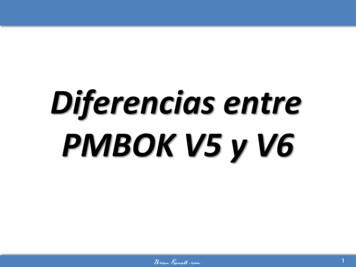
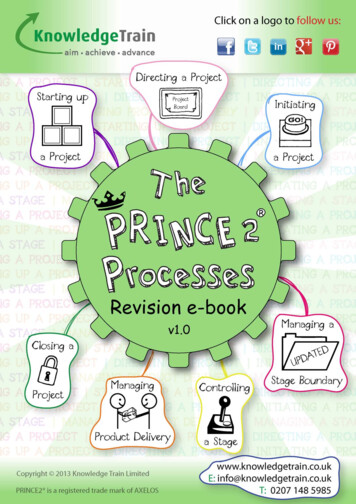
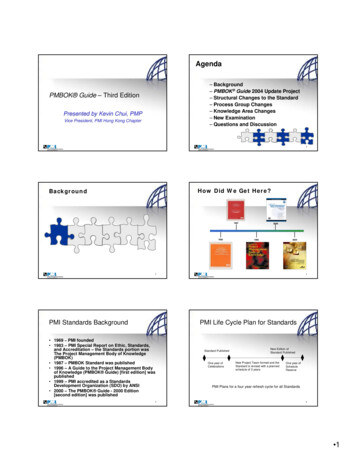
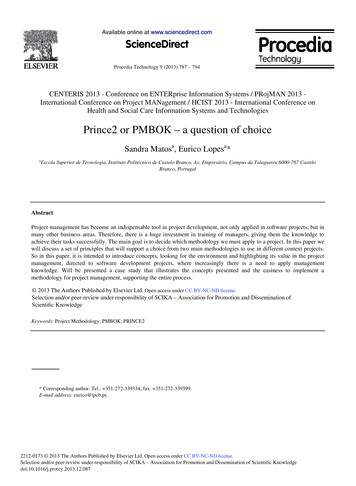
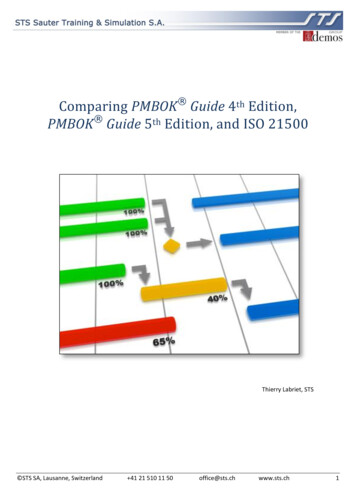
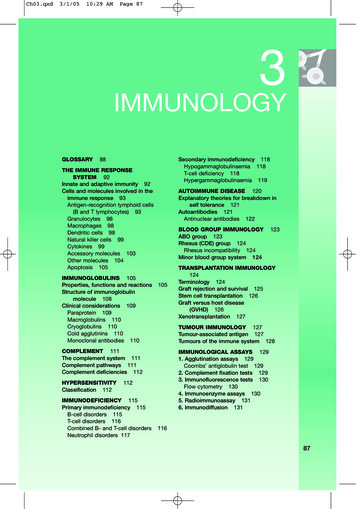
![Managing successful projects with PRINCE2 [PDF] 6th ed.,](/img/18/1-principles.jpg)
